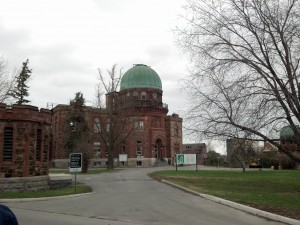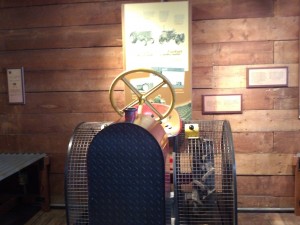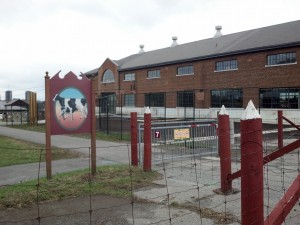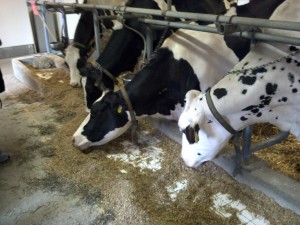Post Conference Review #6: The Ultimate Field Trip!
10 June 2013 – Adina Langer
methods, museums, conference, The Public Historian, conference city review, Canadian Agriculture Museum
Editor’s note: This post continues the series of conference city reviews published by The Public Historian in the Public History Commons
The Ultimate Field Trip! April 20, 2013. NCPH Annual Meeting, Ottawa, Ontario, Canada. Created by: Canada Agriculture Museum. Tour Leader: Franz Klingender, Curator of Agriculture at the Canada Science and Technology Museums Corporation.
Imagining that the second-to-last Saturday in April might bring some spring weather to Canada’s national capital, I eagerly signed up for The Ultimate Field Trip, anticipating a desire for some fresh air and exercise after three long days of sessions in a stuffy conference hotel. As mid-day approached on April 20th, it became clear to me and my tour companions that we were about to get more fresh air (and possibly more exercise) than we had bargained for as Franz Klingender of the Canadian Agriculture Museum led us briskly toward the nearest city bus stop.

Dominion Observatory, located near the north entrance of the Central Experimental Farm (Photo courtesy of Adina Langer.)
Boarding city bus 85 proved to be an auspicious start to our tour of the Central Experimental Farm (CEF) and Canada Agriculture Museum (CAM). I was intrigued by the very notion of a working farm accessible by public transit from the heart of a capital city. When the bus let us off across from the entrance to the farm and we were greeted by a cluster of stately late nineteenth-century research facilities,[i] I felt as if I were about to enter the campus of a Big Ten United States university. I quickly learned that my first impressions were justified. Klingender explained that the CEF was founded in order to teach European immigrants how to farm scientifically in Canada. Similar to the Morrill Act of 1862, which established land grant agriculture and mechanical colleges throughout the United States,[ii] Canada’s CEF was established by An Act Respecting Experimental Farm Stations passed in Parliament in June of 1886.[iii]
In our trek across the contemporary rural landscape, Klingender explained the ways in which the CEF is continuing to fulfill its scientific mission, despite contemporary urban challenges. For example, although the farm itself is protected from development as a designated National Historic Site, it is flanked by high rise apartment buildings, effectively creating a microclimate in which the farm is a valley and the buildings are mountains. Thus, the farm no longer represents the prevailing rural Ottawa landscape, and techniques developed on the CEF are less transferable.[iv] As a result, while maintaining the appearance and historic buildings of the CEF, the Department of Agriculture has had to move certain key experimental activities offsite as it moves forward with more research at the Eastern Cereal and Oilseed Research Centre and other indoor facilities.[v]
This example illustrates the unique relationship between the CEF and the Department of Agriculture, and, within that structure, the relationship between the CAM and the CEF. The CEF must balance its role as a working experimental farm with that of a national historic site, defined as a place that “tells its own unique story, part of the greater story of Canada, contributing a sense of time, identity, and place to our understanding of Canada as a whole.”[vi] If the Central Experimental Farm is the historic heart of the Department of Agriculture, then the Canada Agriculture Museum is the historic and educational heart of the CEF. Still, the museum’s mission to showcase “Canada’s unique agricultural heritage” is complicated by the needs of living, breathing livestock, and the expectations of the museum’s mostly urban visitors.
Klingender’s “Ultimate Field Trip” aimed to emphasize how “the combination of traditional museum exhibits, a livestock herd, and a liberal dash of interactives are used to interpret agriculture to the visiting public.”[vii] But where does the mission to “interpret agriculture” and, as Klingender repeatedly noted in his verbal description of the museum’s mission, “to teach urban people about where their food comes from” end, and the mission to “teach about Canada’s agricultural heritage” begin? In other words, is the Agriculture Museum’s mission contemporary or historical, or both? Heritage implies a deep connection to the past but a trajectory toward the future.
As an institution, the CAM is rooted in the past. It is the only repository for rare historical photos of the CEF.[viii] The CAM also continues to raise breeds of horses and cows that flourished in nineteenth-century Quebec and eastern Ontario, breeds like the Canadienne dairy cow which can subsist on poor quality grass forage and last through cold winters.[ix] Klingender is a font of knowledge about these heritage breeds and other historical aspects of the Agriculture Museum, but without his special knowledge, I think it would be difficult for a visitor to get a sense of any change over time in livestock breeding practices. Having worked in many different science and agriculture museums across Canada, Klingender seems to “know his audience” extremely well, even if that knowledge comes with a mild acerbic attitude about urban visitors and their general ignorance about agriculture. Klingender emphasized that the museum is not there to take sides in debates about agricultural policy; it is there to teach citizens about practices that are currently in use and help them make better policy decisions. This mission is aided by subtle “touch carts” placed in all of the exhibits that gently remind visitors that, for example, the adorable beef cows and calves on display would normally end their lives as hamburgers. Yet, the livestock exhibits lack a sense of the evolution of current practices. What were the scientific, economic, and social factors that led to today’s farming techniques? The CAM’s four-legged ambassadors provide emotionally resonant connections for visitors (who wouldn’t want to pet a calf?), but they don’t provide a lot of historical context.

Interactive device illustrating the difference between steel and rubber tractor tires. (Photo courtesy of Adina Langer.)
The museum’s traditional exhibits do a better job of tracing historical trajectories. “Tractors” illustrates the role of marketing in popularizing new agricultural technology and uses simple but effective interactives (such as a machine on which visitors can sit to feel the difference between rubber and steel tires) to demonstrate how factors such as farmer comfort lead to the evolution of these technologies. “Taking Care of Beesness” provides a comprehensive look at bee husbandry from pollination to honey production and carefully explains the relationship between science and nature in shaping this agricultural industry. Most exhibits at the CAM are changed after five years, but both of these exhibits have been exceptionally popular and up longer than usual.
Klingender closed his tour with a verbal description of the CAM’s newest exhibition, which opened on May 4, in its brand new education center, a refurbishment of a farm building used to hold machinery and thus capable of housing some truly large-scale artifacts. Called “A Piece of Cake,” this exhibit tracks the agricultural processes that go into making an apple cake: the production of flour, eggs, maple syrup, apples, milk, and butter.[x] Going beyond contemporary processes, the new exhibit will explain innovations in the development of these agricultural products and the reasons for these innovations. Such innovations include breeding apple trees smaller (like grapes) to eliminate the need for dangerous apple-picking ladders, and using reverse osmosis machines to reduce the amount of energy needed to turn maple sap into maple syrup. From Klingender’s description, this exhibit has the potential to unite history, heritage, and contemporary education in a way that will benefit the CAM’s audience, fulfill its stated mission, and satisfy picky public historians like me.
~Adina Langer, Artiflection, LLC
[i] “About the Farm – Agriculture and Agri-Food Canada (AAFC),” n.d., http://www4.agr.gc.ca/AAFC-AAC/display-afficher.do?id=1169564397864&lang=eng. Built for the Central Experimental Farm in the late nineteenth and early twentieth centuries, these buildings have been repurposed and continue to serve Canada’s Department of Agriculture in various capacities within the confines of the site’s historic designation.
[ii] “Morrill Act: Primary Documents of American History (Virtual Programs & Services, Library of Congress),” n.d., http://www.loc.gov/rr/program/bib/ourdocs/Morrill.html.
[iii] W.E. Johnson and A.E. Smith, Indian Head Experimental Farm, 1886-1986, vol. 23, Historical Series of Agriculture Canada (Research Branch, Agriculture Canada, 1986), http://epe.lac-bac.gc.ca/100/205/301/ic/cdc/agrican/pubweb/hs23cover.asp. Ch. 1 Accessed May 3, 2013 at http://epe.lac-bac.gc.ca/100/205/301/ic/cdc/agrican/pubweb/hs230003.asp
[iv] Franz Klingender, Interview with the author, April 20, 2013.
[v] “Eastern Cereal and Oilseed Research Centre – Agriculture and Agri-Food Canada (AAFC),” n.d., http://www4.agr.gc.ca/AAFC-AAC/display-afficher.do?id=1180546650582&lang=eng.
[vi] “Parks Canada – National Historic Sites” n.d., http://www.pc.gc.ca/progs/lhn-nhs/index.aspx.
[vii] National Council on Public History, “NCPH 2013 Annual Meeting Program”, 2013, http://ncph.org/cms/wp-content/uploads/2013-Annual-Meeting-Program-Web.pdf. p 10.
[viii] Klingender interview. Franz explained that the CAM seized on a set of photos that were going to be thrown out in the 1980s. Since then, the Department of Agriculture has often requested the use of the photos for presentations to visiting dignitaries.
[ix] “American Livestock Breeds Conservancy: Canadienne Cattle,” n.d., http://www.albc-usa.org/cpl/canadienne.html.
[x] “A Piece of Cake! – Upcoming Exhibition – Canada Agriculture Museum, Ottawa,” n.d., http://www.agriculture.technomuses.ca/english/exhibitions/upcoming_exhibitions.cfm.






1 comment